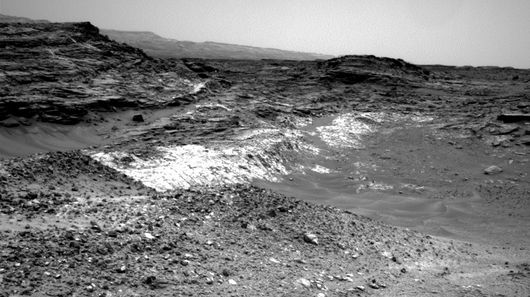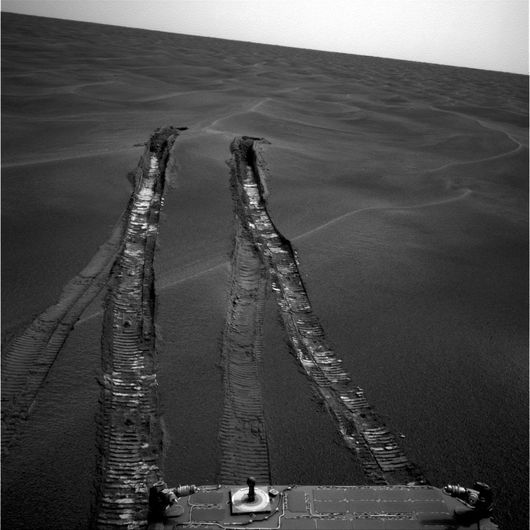Curiosity takes a detour
By Anthony Wood
May 27, 2015

Example of the type of geological feature that the Curiosity team is hoping to examine (Credit: NASA/JPL-Caltech)
NASA's Mars Curiosity rover has been forced to alter its route after being faced with dangerous terrain. The current objective of the robotic explorer is to investigate a geological boundary between two distinct forms of bedrock as a part of its mission to explore the heights of Mount Sharp, and ultimately unlock the secrets of the Red Planet's ancient past.
As you can imagine, driving a rover the size of a small car on a planet some 140 million miles (225.3 million km) away is no easy task, and the job is made all the more difficult when navigating hazardous and loose terrain. At first glance, the path to Curiosity's latest objective had appeared to be made from consolidated rocky materials that would allow the explorer's six aluminum wheels a good degree of purchase, representing a safe, easy option for the mobile laboratory.
In reality, the path selected by mission operators proved to be a challenging prospect, and after three drives, which took place between the 7th and 13th of May, the rover's software detected an excess of wheel slippage that forced it to stop in its tracks.
Wheel slippage runs the risk of appearing a relatively trivial peril for a piece of machinery that has already survived a treacherous entry into the Martian atmosphere, not to mention the subsequent airdrop that so expertly set the pioneer down in Gale Crater. However, rover operators have learnt from the experiences and mistakes of the past, and are certain not to neglect any aspect of the rover's safety.

This image shot by NASA's Opportunity rover back in 2005 shows the deep tracks that the rover cut into "Purgatory Dune"
Gizmag reached out to the Mars rover team for comment on the potential dangers to makind's most advanced robotic explorer. "Slippage can be detected, but only after the fact (after we perform Visual Odometery) so there are concerns with drive precision," stated Chris Roumeliotis of the agency's Jet Propulsion Laboratory (JPL), and team lead for the Curiosity rover drivers. "There is greater uncertainty in Curiosity's drive path when we encounter high amounts of slipping or skidding. Cumulative slip/skid events if not accounted for correctly can lead to driving over unsafe vehicle hazards such as large rocks, large negative features, sand pits, etc."
Roumeliotis went on to explain that if such an error were to go unnoticed or uncorrected, Curiosity could well encounter a scenario similar to that faced in April 2005 by the Opportunity rover, when it was stranded for over a month on "Purgatory Dune." The rover was finally freed after five weeks of painstaking planning, testing, and superb execution by the highly skilled operators.
"Fortunately we have made Curiosity much smarter, and the rover drivers now have better tools to avoid these types of situations on Mars," said Roumeliotis. Therefore, no such crisis was likely to occur for Curiosity, as the rover's handlers took heed of the warning signs, and devised a route to the secondary target location over firmer ground.
"One factor the science team considers is how much time to spend reaching a particular target, when there are many others ahead," stated Curiosity Project Scientist Ashwin Vasavada of the JPL. "We used observations from NASA's Mars Reconnaissance Orbiter to identify an alternative site for investigating the geological contact in the Logan Pass area. It's a little mind-blowing to drive up a hill to a site we saw only in satellite images and then find it in front of us."

First image snapped by the ChemCam instrument following the fix, displaying the texture of a "yellowjacket" rock on Mount Sharp
Curiosity has made good progress towards the new target, with Thursday seeing the explorer undertaking a 72-ft (22-m) drive up a Martian hill, which at points sloped at a 21-degree angle. The rover, which its operators believe to be capable of traversing an inclination of up to 30 degrees under optimal conditions, made light work of the hill, and will soon be unlocking more secrets of the alien environment.
Last week also saw the Curiosity team implement a fix for the rover's Chemistry and Camera (ChemCam) instrument, which is used to take detailed images, and analyze spectrometer readings from sparks zapped by the rover's onboard laser. Unfortunately, a separate laser needed to focus the instrument was lost several months ago, forcing the ChemCam team to struggle on without it.
"Without this laser rangefinder, the ChemCam instrument was somewhat blind," explained principal investigator of the ChemCam instrument at Los Alamos, Roger Wiens. "The main laser that creates flashes of plasma when it analyzes rocks and soils up to 25 feet (7.6 meters) from the rover was not affected, but the laser analyses only work when the telescope projecting the laser light to the target is in focus."
Thankfully, the team was able to send newly-developed software to the robotic pioneer that guides the instrument to take numerous range-finding images in order to inform the focus of the final images, which are then sent back to Earth for analysis.
Wiens offered an optimistic conclusion, stating, "We think we will actually have better quality images and analyses with this new software than the original."
Source: NASA
copyright © Gizmag 2003 - 2015
http://www.gizmag.com/mars-curiosity-rover-wheel-slip/37728/